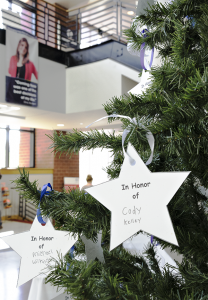Center supports and connects student veterans
By Christina Lieffring

With the U.S.’s presence in Iraq and Afghanistan winding down, the college has seen an increase in veterans on campus. More staff were hired to address veterans’ needs, but with continued increases in enrollment, it soon became clear they needed more space.“We spilled out into the reception area of the third floor,” said Kena Zumalt, veteran service coordinator at the veteran and military Student Resource Center. “By moving into a dedicated space, that puts all our staff together, which is good, but it also allows us to be able to serve the students better.”
The new Veteran and Military Student Resource Center is a “one-stop-shop” to assist veterans with the challenges of transitioning from regimented, military life to the “relatively chaotic” college life, surrounded by students straight out of high school.
“[I]t can be a very isolating experience,” said Zumalt.
When Eric Gromly, an Iraq veteran, was a student, he’d try to hang out at the Student Lounge between classes.
“I felt kind of out of place because I was 25 then,” said Gromly. “And so it’s kind of nice to have a place for veteran students to come.”
The majority of student veterans served in the recent Afghan and Iraq wars – they tend to be older than the average student, married or have children and work full- or part-time.
Chris Hinds, president of the Veterans Club, also served in Iraq and said military veterans also have a different worldview.
“Our outlook on the world is unique because we’ve been to places like [Iraq and Afghanistan] and have seen what we’ve seen,” said Hinds.
Gromly now works in the center, connecting veterans with Veteran’s Affairs (VA) to ensure they receive their benefits.
“I like it that I’m telling people about the same type of benefits I once used because I think it gives them, the veterans, a sense of trust,” he said. “You’re hearing it straight from someone who used the benefits.”
Zumalt is the only non-veteran working in the center and she and her staff have worked hard to create a space where veterans can hang out and connect with fellow veterans.
“There’s no connection like between a veteran and another veteran,” said Hinds. “I could meet a veteran tomorrow that I’ve never talked to and he could find out that I’m a veteran and the instant connection that we have just because of that common military experience is amazing.”
“If you’ve ever been around an older veteran, they just love to talk about their military experience,” said Gromly. “And we – now that we’re all out of the military – we’re getting to that point where we’re all reminiscing on all that.”
One issue discussed frequently is Post- Traumatic Stress Disorder (PTSD), which Hinds is committed to educating veterans on.
“You don’t go to a place like that and come back not changed,” said Hinds. “The thing about PTSD is if you keep pushing it down and pushing it down it gets worse and worse and worse. So one of the big things for me is making sure that everybody’s educated about PTSD and in the right way.”
Hinds works to educate the general public on the disorder as well.
“I have PTSD,” said Hinds. “That does not mean that I’m out in front of my front yard digging holes as the media would like you to think.”
“So education for me is the big thing that I want the veteran’s club to [accomplish].”
On top of being a place to hang out and connect with other veterans and veterans’ services, the center is a safe place for student veterans to seek help about whatever issues they may be facing.
“We try to create a culture of confidence and trust that if a student’s having a hard time, they’ll come in and talk to one of us.” Zumalt.
The average transition time from military to civilian life is from four to eight years.
“It’s nice to know that there are other people on campus that are transitioning that they can talk to about transitioning,” said Gromly.
For veterans making the transition on campus, it’s a relief to know that they are not alone.






















